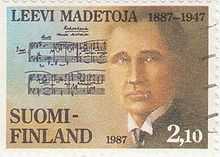Leevi Madetoja

Leevi Antti Madetoja (17 February 1887, Oulu – 6 October 1947, Helsinki)[1] was a Finnish composer.
Life and career
Born in Oulu, he was the son of Antti Madetoja and Anna Hyttinen. His father emigrated to the United States to earn money for the family, but died of tuberculosis by the Mississippi river, never having seen his son.[2]
Madetoja studied music in Helsinki with Jean Sibelius (1906–1910), Paris with Vincent d'Indy (1910–1911) and Vienna and Berlin with Robert Fuchs (1911–1912).[1] In 1913, he married the writer Hilja Onerva Lehtinen (fi, 1882–1972).
His music is strongly influenced by the traditional music of his home region, Ostrobothnia. His three symphonies are based on the legacy of Sibelian and Russian romanticism, Gallic clarity and folk elements.
The sombre Symphony No. 2 was written during the civil war and could be described as a war symphony. Another popular work written in the same year is the elegant piano piece Kuoleman Puutarha (Garden of Death), dedicated to his brother, who had died during the war. His finest works are considered the opera The Ostrobothnians, the Third Symphony, Comedy Overture, the ballet Okon Fuoko, and his songs for male choir. His inspiration slowly dried up, though a fully scored fourth symphony was reportedly lost when his briefcase was stolen at a Paris railway station in 1938. He was planning a violin concerto at the time he died, aged 60, from exhaustion, overwork and heart disease.
Works
A list of Madetoja's compositions:[3]

- Op. 4 – Symphonic Suite (1909–10)
- Op. 5 – Suite of Incidental Music from the play "Chess" (1910)
- Op. 6 – Alcibiades: Incidental Music (1910)
- Op. 7 – Concert Overture (1911)
- Op. 8 – Nine Songs for male voice choir (1908–14)
- Op. 11 – Dance Vision (originally titled "Öinen karkelokuva" ["Night Revels"]) (1911)
- Op. 13 – Six songs for mixed choir (1910)
- Op. 15 – Kullervo: symphonic poem (1913)
- Op. 18 – Sonatina for violin & piano, Op. 18 (1913)
- Op. 23 – Nine Songs for male voice choir (1912–16)
- Op. 29 – Symphony No. 1 (1914–16)
- Op. 33 – Eight Songs for male voice choir (1916–19)
- Op. 34 – Pastoral Suite (1916)
- Op. 35 – Symphony No. 2 (1916–18)
- Op. 37 – Aslak Smaukka: symphonic poem (1917)
- Op. 39 – Five Songs for male voice choir (1919–21)
- Op. 41 – Kuoleman puutarha (The Garden of Death) – suite for piano (1918–21)
- Op. 44 – Four Songs (1919)
- Op. 45 – The Ostrobothnians: opera in three acts (1918–23)
- Op. 46 – Väinämöinen sows the wilderness: symphonic poem (1920)
- Op. 49 – Five Songs (1920)
- Op. 51 – Lyric Suite for cello & piano (1922)
- Op. 52 – Ostrobothnian Suite (1923)
- Op. 53 – Comedy Overture (1923)
- Op. 55 – Symphony No. 3 in A major (1922–26)
- Op. 56 – De Profundis for male voice choir (1925)
- Op. 58 – Okon Fuoko: ballet in one act (1925–27)
- Op. 67 – Three Pieces for brass septet (1929)
- Op. 68 – Autumn: song cycle to poems by L. Oneva (1930)
- Op. 69 – Overture Fantasy for brass (1930)
- Op. 74 – Juha: opera in six tableaux (1934)
- Op. 77 – Rustic Scenes: Suite from the film score "Taistelu Heikkilän talosta" ("The Struggle for the Homestead") (1936)
- Op. 78 – A Wreath of Songs: cantata (1938)
- Op. 81 – Seven Choral Songs (1945–46)
- Op. 82 – Two Songs for mixed choir (1946)
In popular culture
Excerpts from the third and fourth movements of Madetoja's Symphony No. 3 are heard in the Finnish movie The Man Without a Past.
References
- ↑ 1.0 1.1 Leevi Madetoja in Profile by Kimmo Korhonen
- ↑ Lappalainen, Seija & Salmenhaara, Erkki: "The Works of Leevi Madetoja" Suomen Säveltäjät ISBN 951998514X ry 1987
- ↑ Kimmo Korhonen's description of Madetoja's orchestral works
External links
![]() Media related to Leevi Madetoja at Wikimedia Commons
Media related to Leevi Madetoja at Wikimedia Commons
|